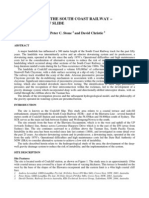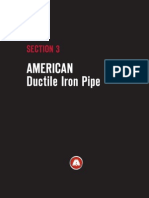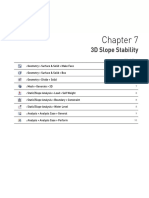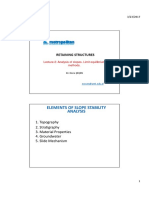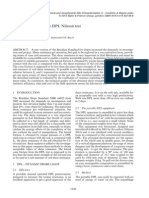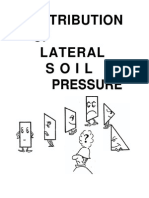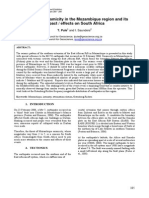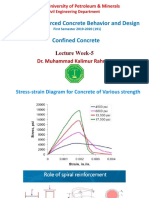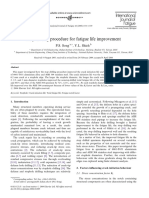Seis Shaking Ex
Seis Shaking Ex
Uploaded by
Aayush VelagaCopyright:
Available Formats
Seis Shaking Ex
Seis Shaking Ex
Uploaded by
Aayush VelagaCopyright
Available Formats
Share this document
Did you find this document useful?
Is this content inappropriate?
Copyright:
Available Formats
Seis Shaking Ex
Seis Shaking Ex
Uploaded by
Aayush VelagaCopyright:
Available Formats
SEISMIC SHAKING AND
EARTHQUAKE
ENGINEERING
_______________________________________________________________________
Supplies Needed
calculator
metric ruler
colored pencils (at least three colors)
______________________________
PURPOSE
The purpose of the exercise is to familiarize you with the effects of earthquakes on
Earth materials and on buildings. The strength of shaking during an earthquake depends
on the amplitude of seismic waves that reach the site, the earth materials at and near the
surface, and the design of buildings and other structures. The purpose of this exercise is to
outline the methods for describing and measuring seismic shaking, and for predicting its
effects on human structures.
SEISMIC SHAKING
Its simple to measure the magnitude of an earthquake, but the pattern of shaking
that results from a single earthquake (called seismic shaking, or seismic ground motion) is
much more complex. At the same time, predicting ground motion is crucial for designing
structures that will withstand the earthquakes likely to occur in an area. Several factors have
to be taken into account to be able to predict ground shaking:
tectonic framework:
number of faults in area, and their distance to the site
types of faults
earthquake recurrence intervals
predicted earthquake magnitudes
near-surface geology
type of material
thickness of unconsolidated material
construction materials and techniques.
- 139 -
Earthquake intensity, introduced in Exercise 2, is an after-the-fact assessment of the
strength and pattern of seismic shaking. The magnitude of earthquakes before the
existence of seismometers can only be estimated indirectly. Earthquake intensities,
however, can be estimated from historical records. The following relationship between
magnitude and maximum intensity has been proposed (Howell, 1973) for shallow-focus
earthquakes:
Imax. = (2 * M) - 4.6
(11.1)
where I max is the maximum intensity, and M is the magnitude of the earthquake.
One problem with intensity measurements is that they are essentially qualitative,
whereas engineers and architects require more quantitative values. Ground motion is most
commonly calculated as acceleration, expressed as a fraction of the acceleration of gravity
(g, where g=9.8 m/sec2). In addition, seismic acceleration can be broken down into its three
perpendicular components: a vertical component (up-down shaking), and two horizontal
components (typically east-west shaking, and north-south shaking). The horizontal
components of shaking commonly are the most damaging to buildings because structures
are already designed to withstand the vertical force of gravity.
2000
1000
Gravity (g=9.8m/sec ) 1.0g
800
700
600
500
0.5g
2
acceleration
400
(cm/sec
300 )
200
0.2g
100
80
70
60
50
40
0.1g
0.05g
30
20
0.02g
10 0.01g
8
I
I
II IV V VI VII VIII
I Modified-Mercally
IX
Intensity
Scale
XI
Seismic Shaking and Earthquake Engineering
above average (firm bedrock)
Condition of earth material
below average (water-saturated soils, mud, man-made fills)
average condition (well-drained compacted soils, sedimentary rocks)
Figure 11.1. Seismic acceleration vs. ground shaking intensity for different
earth materials. (After Leed, 1973)
- 140 -
Seismic Shaking and Earthquake Engineering
Exercise 11
2) Using Figure 11.1 and Equation 11.1, find the peak ground acceleration (in g) on
Mud
bedrock in San Francisco duringBay
an magnitude
7.0 earthquake.
Alluvium
3) How much greater is the acceleration
for man-made fills during a magnitude 7.0
earthquake in this area?
Bedrock
10
15
20
25
30
time (sec)
35
40
45
50
Acceleration at a particular site is related to the distance from the site to the epicenter.
Figure
11.2. Horizontal
ground
motions
of an underground
nuclear
In addition,
acceleration
is related
to earthquake
magnitude
theexplosion
greater the earthquake, the
were
recorded
by
accelographs
in
San
Francisco.
All
materials
were
bigger the acceleration at all locations. An empirical equation (i.e.,
based on observation
to the same
waves. acceleration
(After Borcherdt,
andsubjected
measurement)
relatesseismic
peak ground
(A, in1975)
m/sec2) to earthquake Magnitude
(M) and distance to the hypocenter (R, in km):
4) The vertical axis in Figure 11.2 uses the same scale for all three plots. Calculate how
many times more violent theAground
on A)1.32
bay mud and B) alluvium
= 1080shaking
e 0.5 M /was
(R+25)
(11.2)
compared to bedrock.
Remember that e is the natural exponent function (see Exercise 4 for examples of the
function). This equation was created for California, although it may be applicable in other
plate-boundary settings. As discussed in Regional Focus B, however, intraplate
earthquakes are transmitted farther.
MATERIAL AMPLIFICATION
After tectonic framework, the second major factor that determines the seismic hazard
at a specific location is the type of material under foot. On a local scale, the intensity of
seismic ground motion is mainly a function of surficial geology. The earthquake in 1985
that killed 5600 people in Mexico City was actually centered several hundred kilometers
Inaway
the terminology
seismicMany
waves,
material
amplification
the amplitude
in the PacificofOcean.
coastal
areas
much closerincreases
to the epicenter
than Mexico
of ground
motion,
but the
these waves
is alsofar
important.
Like Destruction
the amplitude,
the
City,
including
theperiod
city ofof
Acapulco,
sustained
less damage.
in Mexico
City
period of
ground
motion
is a function
seismic
thelake
localsediments
geologic which
was
so severe
because
the city of
is both
built the
upon
a thicksource
pile ofand
loose
conditions.
Different
types
of Earth materials each tend to vibrate at a characteristic period,
amplify
seismic
shaking.
known as the fundamental period of that material. Buildings also have a fundamental
period, and theMaterial
fundamental
periods ofis different
buildings
vary
depending
onas
thea height
of surficial
amplification
defined as
increased
seismic
shaking
result of
the structure
and other factors
(Figure
11.4).
and near-surface
deposits.
Amplification
is a function of the composition and thickness of
loose material that underlies an area In particular, sediments and thick soils tend to amplify
seismic waves.
- 142 - - 141 -
Exercise 11
Figure 11.3. The response of a tall building to horizontal ground shaking
compared with the response of a short building. (After Lagorio, 1990)
An important factor in predicting earthquake damage is the relationship between the
fundamental period of a building and the period of the material on which the building is
constructed. If the buildings period equals the fundamental period of the material on
which it is built, or if it equals some whole-number multiple of the materials fundamental
period, then seismic shaking will create a resonance with the building that can greatly
increase the stresses on the structure. Tall buildings tend to be damaged more on deep, soft
soils because of their similar vibrational period. Small, rigid buildings perform poorly on
short-period materials such as bedrock (Figure 11.4).
0
50
Thickness of surficial deposits (m)
100
150
200
250
300
350
Buildings 5 to 9 stories high
80
70
60
Structural damage (%)
50
40
30
Buildings 10 to 14 stories high
20
10
0
0
Buildings over 14 stories high
0.4 0.6 0.8
1.0
1.2
1.4
Fundamental period of soil deposit (sec)
1.6
Figure 11.4. Relationship between building height, thickness of sediments, and
earthquake damage. (After Seed, 1972)
- 143 -
Seismic Shaking and Earthquake Engineering
Exercise 11
unreinforced masonry, brick and mortar, and adobe constructions. Small wood frame
5) At
structures
what fundamental
are usuallyperiod
the safest
(in seconds)
as long is
as the
they
damage
are securely
greatestanchored
for buildings
to their
of: foundations.
Houses that are not anchored or are improperly anchored can shear off their foundations
a) 5-9
stories?
during
lateral
ground motion. Steel frame or reinforced-concrete construction methods are
least hazardous for multi-story buildings or other tall structures.
b) 10-14 stories?
The horizontal components of seismic shaking can be converted into a parameter
called base shear. As mentioned earlier, it is the horizontal components of acceleration that
c) over 14 stories?
are potentially
the most damaging to buildings. Base shear is the maximum lateral force
imposed on a structure during seismic ground motion. Newton's second law states that
force and acceleration are related as follows:
SECONDARY EFFECTS OF EARTHQUAKES
F=m*a
(11.3)
Seismic shaking is considered the primary effect of earthquakes, but2 the majority of
F is the force
Newtons
= 1 N = 1 kg*m/sec
), mearthquake
is the massthat
(in kg)
damagewhere
and casualties
oftenin
result
from (1
theNewton
indirect,secondary
effects. The
2 In this case, F is
and
a
is
acceleration
in
g
(1
g
=
the
acceleration
of
gravity
=
9.8
m/sec
).
struck San Francisco is 1906 is often called the Great Fire of 1906 because it was the
the of
base
m is the mass
of the structure,
is themajority
maximum
horizontalnot
component
three days
fireshear,
that followed
the earthquake
that didand
theagreat
of damage,
the
of
seismic
acceleration.
seismic shaking itself. Major secondary effects of earthquakes include:
The actual baseshear
fire that a building experiences during an earthquake can be calculated
using Equation 11.3.
landslides
A much more applied equation is used by architects and engineers to
calculate the base shear
tsunami
that a structure at a specific site should withstand:
liquefaction
BS = Z * I * (C/R )w* m * g
(11.4)
All of the
effects
listed
above
can
cause
major
damage
during
or
shortly
after
an
earthquake.
where BS is the base shear, Z is the seismic zone factor (a unitless value that incorporates
The bestthe
guide
to where
this type
of damage
will occur
in the Ifuture
where it has
occurred
maximum
seismic
shaking
at different
locations),
is the is
importance
factor
for a
in the past.
Landslide-hazard,
tsunami-hazard,
and
liquefaction-hazard
maps
have
structure (high for a school, for example, and low for a warehouse), C is a been
numerical
compiled
in many ofrelated
the areas
thatconditions,
face the greatest
of these threats in the future.
coefficient
to soil
R likelihood
w is a parameter that assessed the type of
construction used, m is the total mass of the structure (in kg), and g is gravity (9.8m/sec ) 2
We
will focus
on one of these secondary hazards because it is closely linked to
(Lagorio,
1990).
seismic ground motion. Liquefaction occurs in fine, water-saturated sands during strong
seismic shaking.
Water-saturated
their strength
the grains are
rearranged
A building
resists base sediments
shear withlose
the strength
of its as
load-bearing
walls
(shear walls).
during shaking
and
fluid
pressure
increases.
A
sixteenth-century
earthquake
that
struck is the
During east-west-oriented shaking, or when the east-west component of shaking
Port Royal,
Jamaica
caused much
of the town
and of
itsbuilding
inhabitants
simply
to dissappear
into of the
greatest
component,
the north-south
walls
must
withstand
the majority
the ground.
stress. The number and arrangement of shear walls
determines the portion of base shear that each wall
must
withstand. Solid, regular arrangements of walls
BUILDING
CODES
tend to be the strongest; buildings with unsupported
In designing earthquake-safe structures,
the most
important
criteria
is to make
sure
walls,
such as
ground-level
carports,
often
are the most
that no one critical element of the building isvulnerable.
overstressed (the weakest link philosophy).
In other words, the building is only as strong as its weakest link. The standard in designing
a safe building is the capacity or strength of the material
to resist
stresses,
in of two pairs
The building
in seismic
Figure 11.5
consists
particular horizontal acceleration, without failure.
Its important
to understand
thatB seismic
of perpendicular
walls.
Walls A and
each must be
provisions in most building codes are intended
to protect
life and reduce
property
designed
to withstand
one half
of the damage
total base shear.
but not completely eliminate losses. The Structural
Engineers
Association
of California
If shaking
is predominantly
east-west,
then Wall B is
Structures recommend that structures be ableone
to (a)
resistwalls
minor
earthquakes
withoutstress; if
of two
resisting
the seismic
damage, and (b) resist moderate earthquakes shaking
without is
structural
damagenorth-south,
but with some
predominantly
thennonWall A is
structural damage.
in the same situation.
Buildings that are most vulnerable to lateral
induced
seismic waves
are
6) forces
Suggest
simplebymodifications
or additions
to the
- 144 - - 145 -
Seismic Shaking and Earthquake Engineering
building in Figure 11.5 so that both Wall A and Wall B would only need to withstand
one third of the base shear.
CASE STUDY: EARTHQUAKES IN SAN FRANCISCO
The San Francisco Peninsula lies astride the San Andreas fault where it passes
northward from the land to the ocean. In 1906, the city was burgeoning as the preeminent
cultural and economic center west of the Mississippi. At 5:14 a.m. on April 18, the citys
fortunes suffered a severe setback:
At first came a sharp but gentle swaying motion that grew less and less; then a
joltingheavy
sideways then another, heaviest of all. Finally a grinding round of
everything,
irregularly tumultuous, spasmodic, jerky. (Aitken and Hilton, 1906)
Damage was greatest in the Marina District of the city, where liquefaction and settling in the
underlying soft sediments and artificial fill crumbled many buildings. In most of the city,
however, damage was minor, and some residents simply returned to bed. Over 70% of the
damage done in 1906 occurred in the fire that followed the earthquake. In the Marina
district and other pockets of damage, stoves and lamps toppled, igniting scattered blazes.
Firefighters rushed to contain the fires, but watched water pressure drop to a trickle and
then to nothing because water mains had been cut during the shaking. For four days, fire
ravaged the city, consuming 490 city blocks.
The 1906 earthquake and fire were not the first such events to strike San Francisco.
The city was extensively damaged during an earthquake in 1868, in which it was again the
Marina District that suffered the most. In addition, fire had swept through the city three
times previously: in 1849, 1850, and 1851. The extent to which San Francisco had learned
its lessons were again tested in 1989. The Loma Prieta earthquake, a magnitude 7.1 shock
centered about 120 km southeast of the city, caused shaking damage similar in pattern to
the damage in both 1868 and 1906. Liquefaction again caused buildings to collapse in San
Franciscos Marina District, igniting scattered fires, and broke a number of water mains.
Fortunately, technical improvements in the citys water-supply system avoided a repeat of
the 1906 fire. Of the 65 fatalities in the 1989 earthquake, most occurred when a mile-long
(1.6 km) segment of the two-tier I-880 freeway in Oakland collapsed. The freeway
collapsed
wherewalls
it passed
Figureexactly
11.5. Shear
resistover
basesoft, unconsolidated sediments, which amplified the
shakingshear,
and overstressed
the
structure.
supporting a building during
horizontal shaking.
- 146 -
Seismic Shaking and Earthquake Engineering
Exercise 11
Island
_______
_______
_______
_______
_______
___________________________________________________________________
___
_______
___________________________________________________________________
_______
___________________________________________________________________
______
___________________________________________________________________
_______
_______
___
_______
___________________________________________________________________
___________________________________________________________________
___
______
________________
_______
______
______
_______
___________________________________________________________________
________________________
Yerba Buena
______
_______
___________________________________________________________________
___
____________
_______
_______
_______
______
_______
___
____________
_______
___
____________
_______
___________________________________________________________________
___________________________________________________________________
___________________________________________________________________
___
___________________________________________________________________
___
____________
________________
______
___________________________________________________________________
________________
____________
___________________________________________________________________
________________
___________
___________________________________________________________________
____________
________________
___________________________________________________________________
____________
________________
________________________
______
________________________
___
____________
_____
________________________
____________
______
___
____________
____________
________________
____________
___________________________________________________________________
________________
________________________________________
___________________________________________________________________
____________
_____
________________
___________________________________________________________________
________________________________________
____________
________________
___
___________________________________________________________________
________________________________________
________________
____________
___________________________________________________________________
________________________________________
________________
___________________________________________________________________
________________________________________
________________
3 mi
______
________________________
________________________
_____
________________________
____________
___________
___________________________________________________________________
____
__
________________________
___
_____
________________________
____________
___________
____
___________
____
___________
_____
________________________
________________________
3 km
________________________
________________________
____
___________
____
___________
___________________________________________________________________
________________________________________
San Francisco Bay
________________________
________________________
________________________
___________
___________________________________________________________________
________________________________________
______________
_____________
___
________________________
___________
___________________________________________________________________
________________________________________
___________________________________________________________________
________________________________________
______________
___________________________________________________________________
________________________________________
___
________________________
________________________
___
________________________
___
________________________
_____________
______________
___________
______
_____
___________________________________________________________________
________________________________________
______________
___________________________________________________________________
________________________________________ ___________
___________________________________________________________________
________________________________________ ___________
________________________
_____
_____________
______
______________
________________________
_____
_____________
___________________________________________________________________
________________________________________ ___________
________________________
Pacific Ocean
___________________________________________________________________
________________________________________ ___________
___________________________________________________________________
________________________________________ ___________
______
______________
______
______________
___________________________________________________________________
________________________________________ ___________
________
___________________________________________________________________
________________________________________ ___________
_____
________________________
_____________
________________________
_____
_____________
________________________
____
______
______________
____
______
______________
________
______
______________
________
______________
________
______________
________
___
______________
________
_______
___
______________
________
_______
______________
________
_______
______________
________
_______
______________
________
_______
______________
______________________________
________
___________________________________________________________________
________________________________________ ___________
___________________________________________________________________
________________________________________ ___________
_____________
______________
___________________________________________________________________
________________________________________ ___________
____
_____________
________________________
______
_____________
________________________
_____________
___________________________________________________________________
________________________________________ ___________
___________________________________________________________________
________________________________________ ___________
___
___________
_______
___________________________________________________________________
________________________________________ ___________
___________________________________________________________________
________________________________________
___________
___________________________________________________________________
________________________________________
___________
___________________________________________________________________
________________________________________
___________________________________________________________________
________________________________________
______
___________________________________________________________________
________________________________________
___________________________________________________________________
________________________________________
___________________________________________________________________
________________________________________
___
___________________________________________________________________
________________________________________
___________________________________________________________________
________________________________________
___________
___
__
______________________________
_____
___________
___________________________________________________________________
________________________________________
______________________________
___________________________________________________________________
________________________________________
___
___________________________________________________________________
________________________________________
___________________________________________________________________
________________________________________
___________
______________________________
___________
______________________________
___________
______________________________
___________
______________________________
______________________________
___________________________________________________________________
________________________________________
____
___________
___________
California St.
___________
______
___________________________________________________________________
________________________________________
__________
___________
______
______
______
___________________________________________________________________
________________________________________
___________________________________________________________________
________________________________________
___________
______
___________
___
___________________________________________________________________
________________________________________
____
___________
______
___________
______________________________
__
___
____
____
__________
__________
__________
___
______________________________
___________________________________________________________________
________________________________________
___________________________________________________________________
________________________________________
___________________________________________________________________
________________________________________
__________
______________________________
______________________________
___________________________________________________________________
________________________________________
__________
___
____
__________
__________
______________________________
___________________________________________________________________
________________________________________
___________________________________________________________________
_____
_____
_____
_____
_____
_____
_____
_____
_____
_____
__________
______________________________
__________
Bay mud (in places covered with artificial fill as of 1906)
Alluvium (> 30m thick)
Alluvium (< 30m thick)
Bedrock
16th
St.
Figure 11.7. Surficial geology of San Francisco. (After Borcherdt, 1975)
Island
0
0
1
1
Army
St.
3 mi
3 km
San Francisco Bay
very violent
very strong
weak
Figure 11.6. Air-photograph composite of San Francisco. (Image courtesy of
Figure 11.8. Ground-shaking intensity during the 1906 earthquake. (After Borcherdt,
the University of California, Santa Barbara Map and Image Laboratory)
1975)
- 148 - - 147 -
You might also like
- Assignment A2.0 - Slope StabilityDocument3 pagesAssignment A2.0 - Slope Stability2685866No ratings yet
- Landsliding of The South Coast RailwayDocument6 pagesLandsliding of The South Coast RailwayScott DownsNo ratings yet
- Lupini Et Al. (1981) - The Drained Residual Strength of Cohesive SoilsDocument33 pagesLupini Et Al. (1981) - The Drained Residual Strength of Cohesive SoilsJerry BeardNo ratings yet
- Physical LimnologyDocument173 pagesPhysical LimnologyJuan Pablo Ramirez MonsalveNo ratings yet
- Grilla Help Vibrations ENGDocument12 pagesGrilla Help Vibrations ENGafsajghfd1No ratings yet
- (COMSOL) Models - Geomech.slope - Stability PDFDocument22 pages(COMSOL) Models - Geomech.slope - Stability PDFjorgeNo ratings yet
- Surface Subsidence Engineering: Theory and PracticeFrom EverandSurface Subsidence Engineering: Theory and PracticeSyd S. PengNo ratings yet
- A Review of Recent Experience in Modeling of Caving - Mark BoardDocument11 pagesA Review of Recent Experience in Modeling of Caving - Mark BoardFajar SariandiNo ratings yet
- Section 3: American Ductile Iron PipeDocument35 pagesSection 3: American Ductile Iron Pipejosesantimateo100% (2)
- Exam#1 Practice ProblemsDocument5 pagesExam#1 Practice ProblemsNickNo ratings yet
- G - Articulo - Jibson - Predicting Earthquake-Induced Landslide Displacements Using Newmark's Sliding Block AnalysisDocument23 pagesG - Articulo - Jibson - Predicting Earthquake-Induced Landslide Displacements Using Newmark's Sliding Block AnalysisFabián Arquín Bolaños100% (1)
- Ground Response AnalysisDocument19 pagesGround Response AnalysisBhaskar KumarNo ratings yet
- Gravitational Stresses in Anisotropic Rock Masses With Inclined StrataDocument12 pagesGravitational Stresses in Anisotropic Rock Masses With Inclined StratarNo ratings yet
- PSHA For Distributed Seismicity-LapajneDocument14 pagesPSHA For Distributed Seismicity-LapajneredpolNo ratings yet
- Exercise 9 - Hydraulic ConductivityDocument8 pagesExercise 9 - Hydraulic ConductivityAra May BaralNo ratings yet
- Wells Copper Smith 1994Document29 pagesWells Copper Smith 1994Dario PaezNo ratings yet
- Evaluation of The Susceptibility To Flow Liquefaction of An Iron Ore Tailings Using The State Parameter and Yield Stress Ratio ApproachDocument7 pagesEvaluation of The Susceptibility To Flow Liquefaction of An Iron Ore Tailings Using The State Parameter and Yield Stress Ratio ApproachAndréNo ratings yet
- (Okamura, Takemura, Kimura - 1998) Bearing Capacity Predictions of Sands Overlying Clay Based On Limit Equilibrium MethodsDocument14 pages(Okamura, Takemura, Kimura - 1998) Bearing Capacity Predictions of Sands Overlying Clay Based On Limit Equilibrium MethodsMoritz SchleehNo ratings yet
- Lateral Earth PressureDocument15 pagesLateral Earth PressureLingeswarran NumbikannuNo ratings yet
- Boulanger Ziotopoulou 2013 - Formulation of A Sand Plasticity Plane-Strain Model For Earthquake Engineering Applications PDFDocument14 pagesBoulanger Ziotopoulou 2013 - Formulation of A Sand Plasticity Plane-Strain Model For Earthquake Engineering Applications PDFDebdeep SarkarNo ratings yet
- 07 - 3D Slope StabilityDocument14 pages07 - 3D Slope StabilityREMIER100% (1)
- Mogami, T. Kubo. (1953) - The Behavior of Soils During Vibration. Proc. 3rd ICSMFE, Zurich.Document5 pagesMogami, T. Kubo. (1953) - The Behavior of Soils During Vibration. Proc. 3rd ICSMFE, Zurich.marco cavaleiroNo ratings yet
- Irwin - Synthesis of Existing Structural Data For The Auckland Volcanic FieldDocument213 pagesIrwin - Synthesis of Existing Structural Data For The Auckland Volcanic FieldRamanditya WimbardanaNo ratings yet
- Ubchyst2d For Flac 2dDocument8 pagesUbchyst2d For Flac 2dFrank Perez CollantesNo ratings yet
- Earthquake Records and Measuring InstrumentsDocument42 pagesEarthquake Records and Measuring InstrumentsJoshua John JulioNo ratings yet
- 5.CE 483 Settlement 3rd 1444Document82 pages5.CE 483 Settlement 3rd 1444Saad MohammedNo ratings yet
- The Shear Strength Reduction Method For The Generalized Hoek-Brown CriterionDocument6 pagesThe Shear Strength Reduction Method For The Generalized Hoek-Brown CriterionEmrePınarcıNo ratings yet
- An Empirical Failure Criterion For Rocks and Jointed Rock MassesDocument19 pagesAn Empirical Failure Criterion For Rocks and Jointed Rock MassesYiwei LiNo ratings yet
- Assessment of Seismic Site Conditions A Case Study From Guwahati CityDocument24 pagesAssessment of Seismic Site Conditions A Case Study From Guwahati CityfatenNo ratings yet
- MODULE 2 GEOTECHENGG mk2 PDFDocument39 pagesMODULE 2 GEOTECHENGG mk2 PDFCarla MesaNo ratings yet
- Applications of Tromino (R) and SoilSpy ENG 2.0Document12 pagesApplications of Tromino (R) and SoilSpy ENG 2.0NurhadiNo ratings yet
- Elements of Slope Stability Analysis: Retaining StructuresDocument22 pagesElements of Slope Stability Analysis: Retaining StructureskorbiNo ratings yet
- Allowable Bearing Capacity - Academic Journals PDFDocument9 pagesAllowable Bearing Capacity - Academic Journals PDFA KNo ratings yet
- Seismic Response of Earth Dams Gazetas 1987Document46 pagesSeismic Response of Earth Dams Gazetas 1987nietocristian4630No ratings yet
- Probabilistic Landslide Hazard Methodology For A Highly Susceptible Area To LandslidesDocument9 pagesProbabilistic Landslide Hazard Methodology For A Highly Susceptible Area To LandslidesJournal of Architectural Design and Construction TechnologyNo ratings yet
- Modification of Slope Mass Rating (SMR) by Continuous FunctionsDocument8 pagesModification of Slope Mass Rating (SMR) by Continuous FunctionsArthur MatosNo ratings yet
- Excess Pore-Water Pressure Using Skemptons B-BarDocument5 pagesExcess Pore-Water Pressure Using Skemptons B-BarPuspa ChandNo ratings yet
- Rock-Engineering Tutorials Solutions BBDDocument7 pagesRock-Engineering Tutorials Solutions BBDSandip PaudelNo ratings yet
- Seismic Hazard AnalysisDocument23 pagesSeismic Hazard AnalysisOmar Ic100% (1)
- Chinnery 1966 FaultsDocument16 pagesChinnery 1966 FaultsrNo ratings yet
- Shear Resistance by The DPL Nilsson TestDocument9 pagesShear Resistance by The DPL Nilsson TestBookAncestorNo ratings yet
- Rocplane: Planar Sliding Stability Analysis For Rock SlopesDocument31 pagesRocplane: Planar Sliding Stability Analysis For Rock SlopesGonzalo Andres Bouldres VargasNo ratings yet
- Effect of The Axis of Moment Equilibrium in Slope Stability AnalysisDocument10 pagesEffect of The Axis of Moment Equilibrium in Slope Stability AnalysisHan LeeNo ratings yet
- Calculo Empujes LateralesDocument24 pagesCalculo Empujes LateralesOscar PelaezNo ratings yet
- Vlachopoulos PDFDocument16 pagesVlachopoulos PDFSérgio BernardesNo ratings yet
- Introduction To Engineering Seismology: KeywordsDocument34 pagesIntroduction To Engineering Seismology: Keywordsbiles1234No ratings yet
- General: Search MethodsDocument3 pagesGeneral: Search MethodsDionisioNo ratings yet
- Technical Manual For Design and Construction of Tunnels 1Document1 pageTechnical Manual For Design and Construction of Tunnels 1John WT'FankNo ratings yet
- Overcoring MethodsDocument4 pagesOvercoring MethodsKevin EduardoNo ratings yet
- Methods For Assessing The Stability of Slopes During Earthquakes-A Retrospective 1Document3 pagesMethods For Assessing The Stability of Slopes During Earthquakes-A Retrospective 1ilijarskNo ratings yet
- CPTGuide Jan 2009 Edition 3Document134 pagesCPTGuide Jan 2009 Edition 3faisal_shellNo ratings yet
- EC-Landslides and Climate Change-Challenges and SolutionsDocument488 pagesEC-Landslides and Climate Change-Challenges and Solutionsviorel popNo ratings yet
- Critical State Soil Mechanics: Andrew Schofield and Peter WrothDocument3 pagesCritical State Soil Mechanics: Andrew Schofield and Peter WrothinnermanifestoNo ratings yet
- Prediction of Resilient Modulus From Soil Index PropertiesDocument71 pagesPrediction of Resilient Modulus From Soil Index Propertiessamer100% (1)
- AWMSGAB Volume II PDFDocument264 pagesAWMSGAB Volume II PDFTusharGuptaNo ratings yet
- SRDS Lecture 6 Seismic Hazard Analysis (PSHA)Document27 pagesSRDS Lecture 6 Seismic Hazard Analysis (PSHA)prraaddeej chatelNo ratings yet
- Empirical Correlations of Shear Wave Velocity (VS) and Standard Penetration Resistance Based On Soil Type in Babol CityDocument12 pagesEmpirical Correlations of Shear Wave Velocity (VS) and Standard Penetration Resistance Based On Soil Type in Babol CityAbdelmoez ElgarfNo ratings yet
- 3D Limit Equilibrium Slope StabilityDocument9 pages3D Limit Equilibrium Slope StabilityBoris Leal MartinezNo ratings yet
- Chapter 4 - Plasticity of SoilDocument15 pagesChapter 4 - Plasticity of SoilHussein EssaNo ratings yet
- Sismo 2006 MocambiqueDocument6 pagesSismo 2006 Mocambiquegege-mzNo ratings yet
- Hydrochemistry of Groundwater From Sarabanga Minor River Basin, Tamilnadu, IndiaDocument11 pagesHydrochemistry of Groundwater From Sarabanga Minor River Basin, Tamilnadu, IndiaSrinivasamoorthy krishnarajNo ratings yet
- Seis Shaking ExDocument11 pagesSeis Shaking ExJimmy JuarezNo ratings yet
- Lecture-Week4-Confined Concrete-Term 191Document25 pagesLecture-Week4-Confined Concrete-Term 191ehabNo ratings yet
- SE P5r1Document18 pagesSE P5r1BQ HeNo ratings yet
- Graphics Geologic StructuresDocument12 pagesGraphics Geologic StructuresSaeed KariminasabNo ratings yet
- TENSION MEMBER (Compatibility Mode)Document44 pagesTENSION MEMBER (Compatibility Mode)ArThur BangunNo ratings yet
- Design of Tension Member LRFDDocument57 pagesDesign of Tension Member LRFDJerome Angelo B. Baybay100% (1)
- Buckling TutorialsDocument10 pagesBuckling TutorialsNkanyiso MsweliNo ratings yet
- SPE-189826-MS DFIT Analysis in Low Leakoff Formations: A Duvernay Case StudyDocument15 pagesSPE-189826-MS DFIT Analysis in Low Leakoff Formations: A Duvernay Case StudyMohammed IbrahimNo ratings yet
- Review of Design Methods For ExcavationsDocument196 pagesReview of Design Methods For ExcavationsDoan Duy Thinh100% (2)
- Stop Drilling Procedure For Fatigue Life Improvement: P.S. Song, Y.L. ShiehDocument7 pagesStop Drilling Procedure For Fatigue Life Improvement: P.S. Song, Y.L. ShiehBayu Aji PamungkasNo ratings yet
- Kathmandu Engineering College: Tutorial On Strain EnergyDocument2 pagesKathmandu Engineering College: Tutorial On Strain EnergyAlbie DahalNo ratings yet
- Ground Improvement TechniquesDocument17 pagesGround Improvement Techniquesjs kalyana rama100% (1)
- Handout 7 - Answer KeyDocument1 pageHandout 7 - Answer Keyjustsmile69No ratings yet
- Structural Design Short FormulaDocument5 pagesStructural Design Short FormulaMIslamMonirNo ratings yet
- How To Draw Your Own Column InteractionDocument23 pagesHow To Draw Your Own Column InteractionErwin ObenzaNo ratings yet
- Design of Structural ElementsDocument22 pagesDesign of Structural Elementsengsam777No ratings yet
- Unit 6 Earthquake and FaultsDocument33 pagesUnit 6 Earthquake and FaultsJohn Mark LaurioNo ratings yet
- Triaxial Test SystemsDocument9 pagesTriaxial Test SystemsAfifah FauziNo ratings yet
- ENGR 252 SYL Spring11Document3 pagesENGR 252 SYL Spring11Jason CarianNo ratings yet
- Ci33 1112 Pernos de AnclajeDocument10 pagesCi33 1112 Pernos de AnclajeShadin Asari ArabaniNo ratings yet
- Calculation Report For PHC Pile: I. Input Data For Pile's Material I.1. Effective Presstress: ValueDocument3 pagesCalculation Report For PHC Pile: I. Input Data For Pile's Material I.1. Effective Presstress: ValuehuhumaluNo ratings yet
- Column-Footing Size 3Document8 pagesColumn-Footing Size 3Anonymous HJ7hmihhNo ratings yet
- RMC - P1 - May 2012 - Model - AnswersDocument23 pagesRMC - P1 - May 2012 - Model - AnswersJaco RademeyerNo ratings yet
- Assessment of Tunnelling-Induced Building DamageDocument10 pagesAssessment of Tunnelling-Induced Building DamageMarco NevesNo ratings yet
- Ad-A281 365Document237 pagesAd-A281 365EuNo ratings yet
- Lecture - 09 Compression Members ProblemsDocument52 pagesLecture - 09 Compression Members Problemssaleemm_2100% (1)
- ACI 318-14 ColumnaDocument4 pagesACI 318-14 ColumnaMoy ReapNo ratings yet
- To Determine The UCS of Samples by Using Point Load Strength IndexDocument5 pagesTo Determine The UCS of Samples by Using Point Load Strength IndexBoos yousufNo ratings yet

